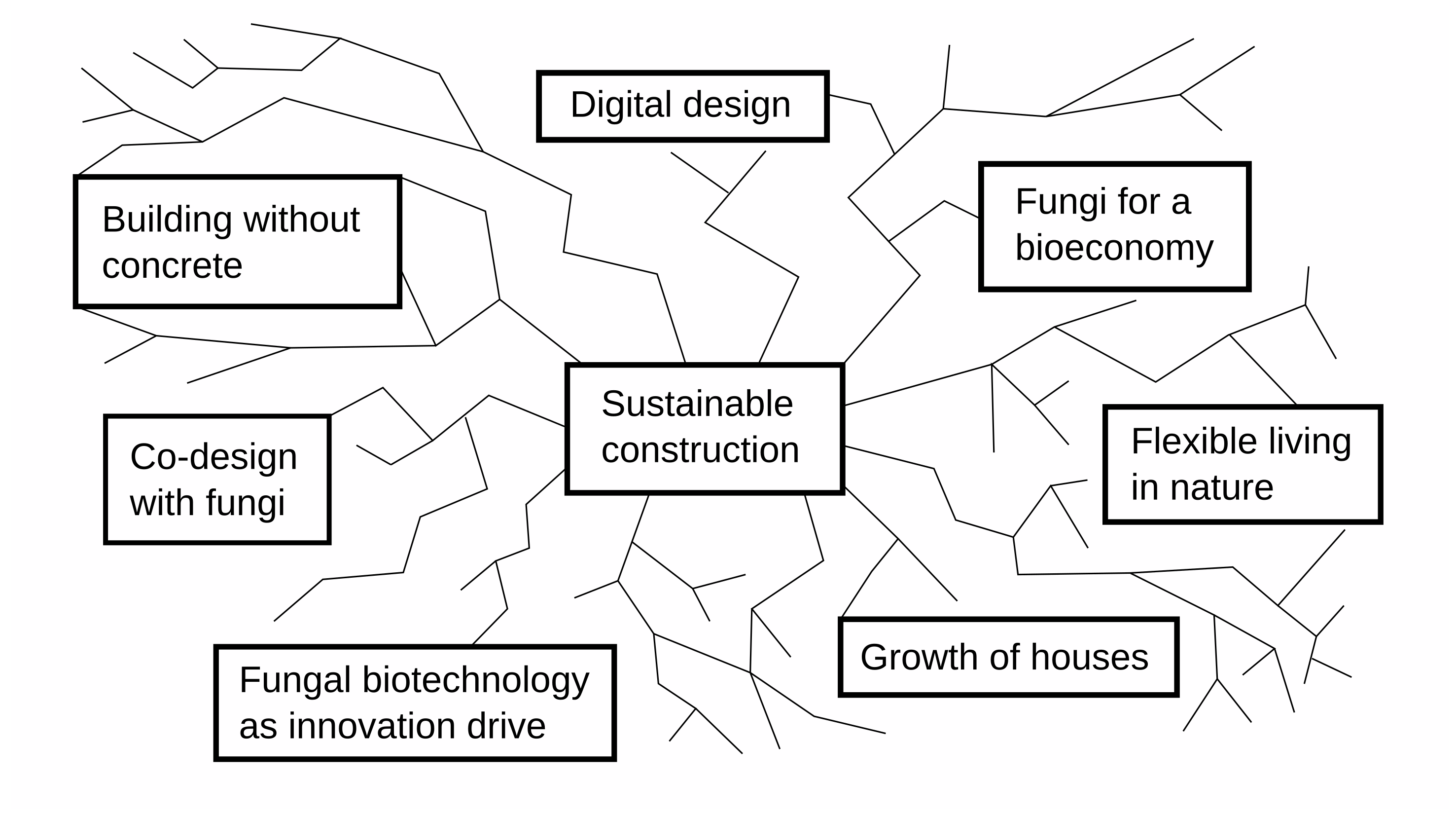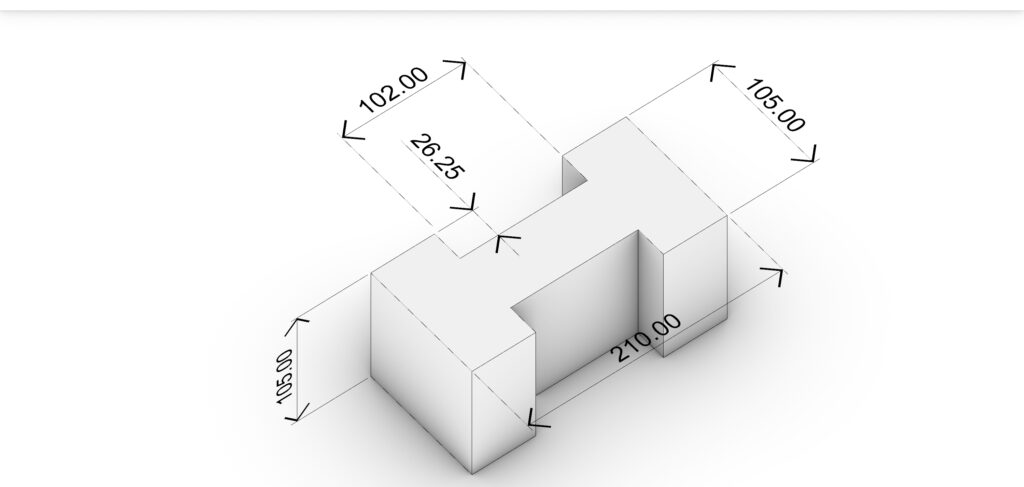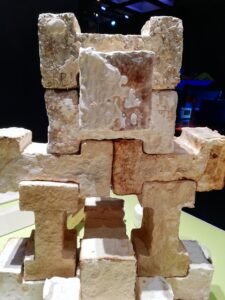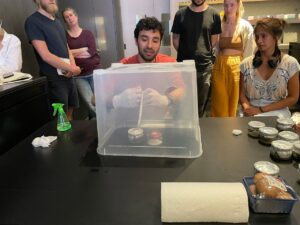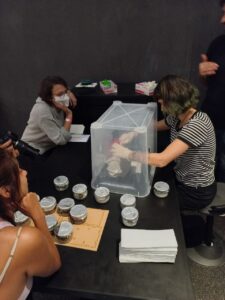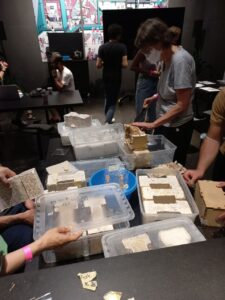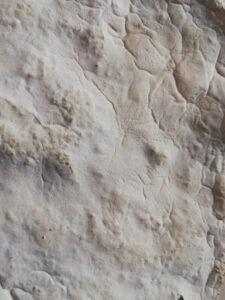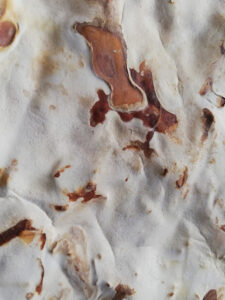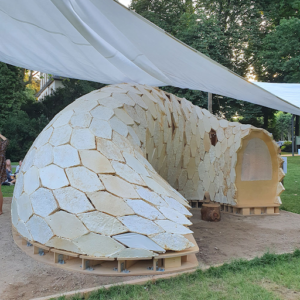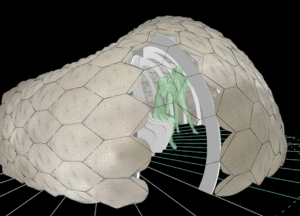Link to resources -> http://www.top-ev.de/mushroomresources
Link to workshop registration -> No workshops available now
Link to the open access book “Engage with Fungi” -> https://verlag.tu-berlin.de/en/produkt/978-3-98781-000-8/
MY-CO BUILD
We are looking for sustainable alternatives to conventional construction materials.
Introduction
The steadily growing population and the associated need for more building activities pose almost insurmountable challenges for architecture and the industry as a whole, on the one hand, and on the other hand enormous CO2 emissions. The construction industry is one of the world’s biggest climate killers. Sustainable growing materials such as mushrooms could therefore be a promising alternative. This is because composites made from mushrooms could be produced in the near future in a way that is both climate-friendly and cost-effective. In addition, mushroom mycelium can be easily separated and fully composted after the end of a building material’s life. Thus, the use of fungi could create a lightweight and fully circular building system.
Prototyping a modular myco-brick
By S. Pfeiffer
About MY-CO BUILD
MY-CO BUILD is the title of a transdisciplinary research project and a changing exhibition by the Berlin-based SciArt collective MY-CO-X, founded in 2020 by Prof. Vera Meyer (TU Berlin, biotechnologist and artist) and Prof. Sven Pfeiffer (HS Bochum, architect and designer) which can be experienced from 2021 until 2024 at the Futurium in Berlin. The focus of the exhibition is on biotechnologically obtained fungal-based biomaterials, which are being researched in cooperation with many academic and non-academic partners as building materials for a sustainable architecture of the future. The exhibition is accompanied by open lab evenings as well as public fungal cultivation courses, which were originally developed together with TOP lab as part of the Mind the Fungi project [1] [2] [3] and developed further for MY-CO BUILD in close cooperation with Alessandro Volpato from TOP Lab, Logan Noonan, Annemarie Nazarek from KiezPilz and Stefanie Holzheu from Futurium Lab. The exhibition illuminates and accompanies the ongoing research process, enables the interested public and the Berlin do-it-yourself (DIY) scene to actively participate in it, and continues to evolve through changing scientific, artistic, civic and architectural exhibits.
More specifically, we as TOP Lab question, how the experience gained during the citizen science project “Mind the Fungi [1] [2] [3] (2018 – 2020) and the project “MY-CO SPACE [4]” (2021) by MY-CO-X can be applied to replace troublesome elements in buildings.”
[1] https://depositonce.tu-berlin.de/handle/11303/11468
[2] https://artlaboratory-berlin.org/research/mind-the-fungi/
[3] www.top-ev.de/about/lab/mind-the-fungi/
[4] www.youtube.com/watch?v=KAipr83e_CE
Fungal composite bricks – Exhibition at Futurium Berlin
by A. Volpato
Methods
In this project we try to see if and how fungal composite bricks can be used as structural elements of a building. We use a transdisciplinary approach. We push scientific exploration beyond the competence of a single scientist and generate ideas across different fields of expertise, such as mycology, architecture and art. This has been made possible through a cooperation of community-based groups (TOP Lab, KiezPilz) with partners from academia and the museum world (Futurium).
The architect Sven Pfeiffer designed modular bricks that can be assembled in different ways, to create walls, corners or other structures. The mycology expertise generated from Vera Meyer’s group at TU Berlin was used to grow the bricks. The community groups lead the activities of co-creating the bricks with individuals from the society.
Fotos: Workshop at Futurium – Growing the fungal composite bricks for the exhibition
Activities
We host a four days workshop series under the Futurium umbrella, where participants learned how these materials are done. Each day we reproduced one step of the material’s production. During the 4 days, we covered the whole process while producing bricks.
We used the same format adopted and described in “Mind the Fungi”.
We modified the laboratory protocols to be reproducible at home. We used accessible tools and gave crash courses to give participants the knowledge required also explaining jargon and technical concepts. In the end, we assembled an artistic structure at Futurium, where the features of the blocks were displayed.
About Fungi and fungal composite materials in architecture (from the work of Vera Meyer and Sven Pfeiffer)
[5] www.youtube.com/watch?v=4Ny3DvhIEos
As Vera Meyer from the TU Berlin explains in the MY-CO BUILD video [5], fungi decompose plants and transform this organic matter into humus. They cultivate fungi at the TU Berlin (Department of Applied and Molecular Microbiology) on residues from agriculture and forestry, thus simulating the natural life of fungi, and control that process and interrupt it at a certain point. The interruption prevents the fungi from completely digesting the plants and freezes the process in a three dimensional shape. And that’s where these composites are created.”
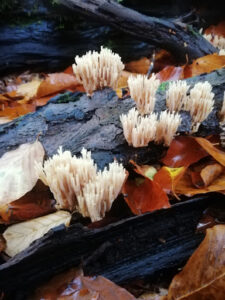
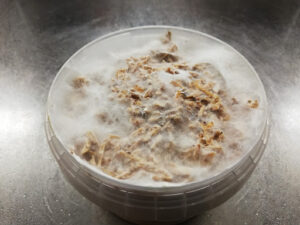
Coral mushrooms in the forest
Mushrooms growing in a Petri dish
Photos by A. Volpato
We can’t expect these materials to be a perfect replacement to the current troublesome materials we use, like concrete. But we can do new things with them.
We can have very soft surfaces in architecture that actually have a certain scent, a certain haptical feel, and can thus give us a new relationship to the built environment.
The surface
Photos by A. Volpato
The resulting structures which we work with, are grown in four, five, six corner shapes. This relates with our concept of a modular design. These shapes can be easily combined with each other to build bigger surfaces with interesting priorities such as thermal insulation or improving the acoustics of a closed space.
MY-CO-SPACE
by MY-CO-X, Sci-Art Collective,
©Vera Meyer
We orient ourselves to “co-design with fungi” not only in the materials, but also in the shape. This is because nature provides us with a whole repertoire that is also very efficient regarding load-bearing properties. In our experiments we test fungal materials as structural components in building.
And of course we play with these forms.
Visualization interior of MY-CO-SPACE
by MY-CO-X, Sci-Art Collective, tinyBE #1
©Sven Pfeiffer, MY-CO-X
Fungi grow wonderfully on plant-based substrates. Interestingly, they can be brought in contact with concrete. And then their cell threads grow into the concrete and actually connect concrete parts with one other.
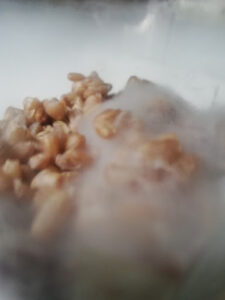
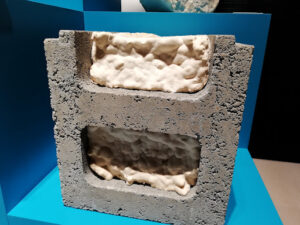 Growing materials on rye at TOP lab and fungal-plant-concrete composite materials developed by Vera Meyer’s lab at the TU Berlin
Growing materials on rye at TOP lab and fungal-plant-concrete composite materials developed by Vera Meyer’s lab at the TU Berlin
Photos by A. Volpato
These shapes are created with the help of new building and manufacturing methods. We cut the frames with a laser and put them together to define the growth of the fungus.
In other words, there is a certain digital process that meets with a natural material and together creates a new materiality. We use digital design to rethink the future of building.
Sven Pfeiffer, architect, thinks that all unfolding events that we see in the news, the climate change, the scarcity of natural resources will, deeply influence our understanding of architecture of the future anytime soon. And there will be a big change of mind.
We will continue to use materials such as concrete for a while, but at some point we will be forced by necessity to switch to these new bio-based materials; and the earlier we accompany this development (embrace this change) and make these materials appealing in terms of design, the better.
In the future, but already now, architects will have to work a lot with existing buildings. All the buildings around us, be they ruined or new, contain a lot of embedded energy. And to demolish these buildings is becoming a more and more difficult decision to make.
Which is a good thing, because it means we can also convert these buildings and recycle that embedded energy instead of wasting more energy to dispose of it.
There is a lot of old concrete that has to be recycled as Vera Meyer says. “That means we don’t even have to think about how we can build without concrete in the future; instead, we have to think about how to make new construction possible with recycled concrete. The utopia that we envision, is a completely sustainable construction approach.
The utopia that we envision, is a completely sustainable construction approach. But perhaps this revolution is only possible through a step by step evolution, where each step enables the adoption of different approaches with bio-based materials.
Vera Meyer, Sven Pfeiffer and their SciArt collective MY-CO-X are currently in an experimental phase, which is very exciting. By collaborating with architects, with building physicists, with material scientists, with sustainability researchers from the TU Berlin and beyond, they aggregate multi- and transdisciplinary expertise, which allows them to understand which materialities can be achieved.
And on the other side, what is the ecological balance?
And is that the right way?
Or do we perhaps have to rethink one or the other thought?
Now it is the right moment for new, innovative materials, which are produced biologically and are completely biodegradable. The MY-CO-X collective is thus working on an utopia, which they hope will be a reality in ten years: living in a fungal house. Because Vera Meyer and Sven Pfeiffer understand that this transition won’t happen just by keeping the knowledge within academia, research institutes or closed groups, they want to share the know-how and involve as many as possible. At TOP Lab, in collaboration with KiezPilz, we are thus hosting courses to train enthusiasts interested in designing and producing these fungal based materials.
About the workshop
Based on the experience gained during the “Mind the Fungi” collaboration, we adapted the home cultivation methods and made the course suitable to teach how to integrate biodesign and architecture.
During the experience, participants grew myco-blocks, which are used to build a bigger mushroom structure.
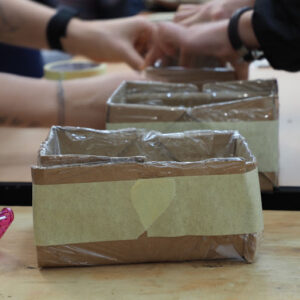
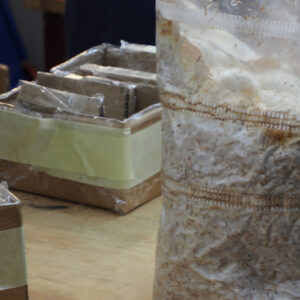 Producing the negative molds
Producing the negative molds
Photo by A. Nazarek
The myco-blocks have plenty of features. Their modularity echoes in the faces, in the edges, in the corners and in the different ways they can be assembled.
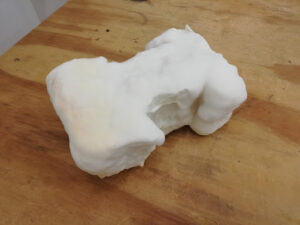
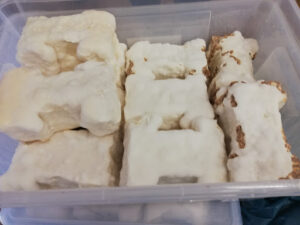 Bricks before being dried
Bricks before being dried
Photo by A. Volpato
By training individuals, we are not only speeding up the transition towards these materials, but also empowering individuals in understanding and tackling the challenges of our times, which are formulated in the 17 goals for sustainable development of the United Nations.
MY-CO BUILD is run in collaboration with:
Prof Dr.-Ing. Vera Meyer, biotechnologist, chair of the AMM department at TU Berlin (Applied Molecular Microbiology) and artist
Prof. Sven Pfeiffer, architect, professor at Bochum University of Applied Sciences and Studio owner
Alessandro Volpato, biologist and freelancer, >top e.V. member
Logan Noonan, KiezPilz co-founder
Annemarie Nazarek, KiezPilz co-founder

